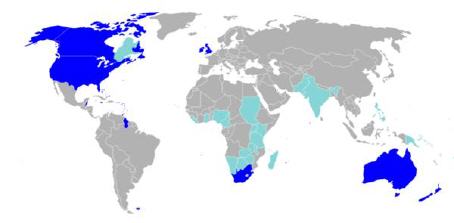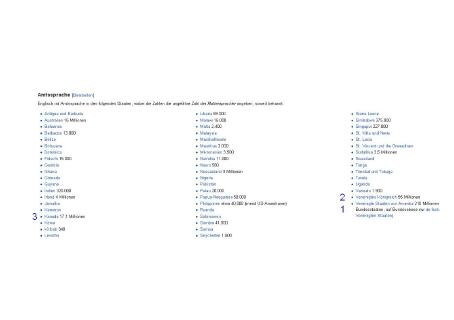Länder mit E

GNU Lizenz Wikipedia
Lerne Englisch! Du wirst es nicht nur beim Reisen brauchen!
Länder mit Englisch Muttersprache Englisch u. viel
Arbeitsblatt Karte Aufgabe Geografie Englische Länder der Welt...
Arbeitsblatt Text Aufgabe Spezialthema USA...
Heute sind weltweit etwa 340 Millionen Menschen anglophon, das heißt: sie sprechen Englisch als Muttersprache. Weitere 170 Millionen Menschen beherrschen es als Zweitsprache, so dass das Englische auf insgesamt 510 Millionen Sprecher kommt. Dunkelblau: Länder mit Englisch als offizieller oder De-facto-Amtssprache. Türkis: Länder, in denen Englisch gesprochen wird, es aber nicht die Hauptsprache ist. In der Europäischen Union ist Englisch eine offizielle Amtssprache. (Mausklick auf die jeweiligen Regionen führt zum jeweiligen Artikel.)
Countries where English is a majority language are dark blue; countries where it is an official but not a majority language are light blue.
English is also one of the official languages of the European Union.
Click an you have add to the countries! de.wikipedia.org/wiki/Englische_Sprache wählen...
Neu: Nach Canada und Australien bieten wir neu auch Sprachkurse Neuseeland an!
userlearn.ch und ch-info.ch - das KMU - Netzwerk empfehlen Frau Villens Sprachreisen bestens, viele unserer SchülerInnen ware bereits vor 10 Jahren in Canada!
Das Sprachreisen Neuseeland Angebot ist zwar neu bei Frau Villen und Ihrem Team, aber wir versichern Ihnen, dass Pres/Leistung sehr gut sind!
... und das wichtigste, bei Problemen haben Sie eine kompetente Ansprechperson in der Schweiz - die die Sprachschule persönlich kennt!
English is the de facto national language of the United States, with 82% of the population claiming it as a mother tongue, and some 96% claiming to speak it "well" or "very well".However, no official language exists at the Federal level. There have been several proposals to make English the national language in amendments to immigration reform bills, but none of these bills have become law with the amendment intact. The situation is quite varied at the State and Territorial levels, with some states mirroring the Federal policy of adopting no official language in a de jure capacity, others adopting English alone, others officially adopting English as well as local languages, and still others adopting a policy of de facto bilingualism.
The variety of English spoken in the United States is known as American English, together with Canadian English it makes up the group of dialects known as North American English.
Spanish is the second most common language in the country, and is spoken by over 12% of the population. The United States holds the world's fifth largest Spanish-speaking population, outnumbered only by Mexico, Spain, Argentina, and Colombia. Throughout the Southwestern United States, long-established Spanish-speaking communities coexist with large numbers of more recent Spanish-speaking immigrants. Although many new Latin American immigrants are less than fluent in English, nearly all second-generation Hispanic Americans speak English fluently, while only about half still speak Spanish.
According to the 2000 US census, people of German ancestry make up the largest single ethnic group in the United States, and the German language ranks fifth. Italian, Polish, and Greek are still widely spoken among populations descending from immigrants from those countries in the early 20th century, but the use of these languages is dwindling as older generations pass away. Russian is also spoken by immigrant populations.
Tagalog and Vietnamese have over one million speakers in the United States, almost entirely within recent immigrant populations. Both languages, along with the varieties of the Chinese language, Japanese, and Korean, are now used in elections in Alaska, California, Hawaii, Illinois, New York, Texas, and Washington.
There is also a population of Native Americans who still speak their native languages, but these populations are decreasing, and the languages are almost never widely used outside of reservations. Hawaiian, although having few native speakers, is an official language along with English at the state level in Hawaii. The state government of Louisiana offers services and documents in French, as does New Mexico in Spanish. Besides English, Spanish, French, German, Navajo and other Native American languages, all other languages are usually learned from immigrant ancestors that came after the time of independence or learned through some form of education.
Approximately 337 languages are spoken or signed by the population, of which 176 are indigenous to the area. 52 languages formerly spoken in the country's territory are now extinct.
Lese und übersetze es singemäss! Vergleiche mit der D- Version auf Wikipedia! Gut übersetzt, sollte man das D oder E ändern? Wenn es Sie reizt auf Wikipedia mitzuarbeiten, kontaktieren Sie
Obwohl die Vereinigten Staaten keine festgelegte Amtssprache haben, ist Englisch faktisch Nationalsprache. Es wird von 82 % der Bevölkerung als Muttersprache und von fast allen Einwohnern als Verkehrssprache verwendet.
Spanisch wird als erste Fremdsprache gelehrt, besonders in Gebieten mit einem hohen lateinamerikanischen Bevölkerungsanteil, wie in Staaten, die an Mexiko grenzen, sowie in Florida und den Städten Chicago und New York. Jüngere Generationen, die aus keiner Familie mit spanischprachigem Hintergrund stammen, lernen die Sprache in zunehmend höherer Zahl aufgrund der wachsenden Anzahl der spanischsprachigen Weltbevölkerung.
Ca. 12 %, über 30 Millionen US-Amerikaner, die Spanisch als Muttersprache oder Zweitsprache sprechen, machen die USA zum Land mit dem fünftgrößten spanischsprachigen Einwohneranteil weltweit, nach Mexiko, Kolumbien, Spanien und Argentinien. In den Südweststaaten ist der Bilinguismus (Zweisprachigkeit) sehr weit verbreitet.
Das Chinesische, vor allem das Kantonesische, bildet die drittgrößte Sprechergemeinschaft der Vereinigten Staaten und ist besonders in Kalifornien vertreten. Quelle Cc by nc: mehr
http://en.wikipedia.org/wiki/Languages_of_the_United_States




